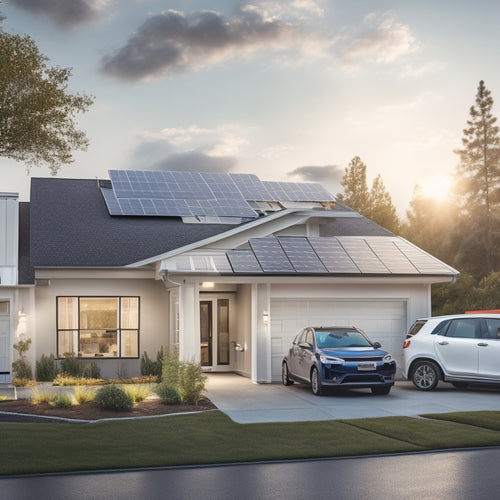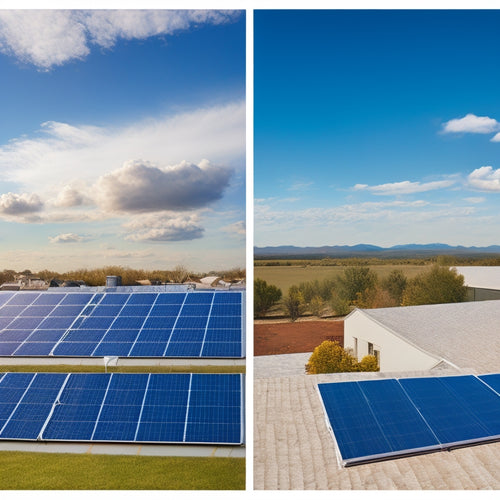
What Causes Solar Installation Costs to Vary by Location?
Share
When you're considering solar installation, you'll find that costs vary greatly depending on your location. Local labor costs and availability play a huge role, with wage disparities and labor market capacity affecting project timelines and scope. Regional permitting and inspections, utility company interconnection fees, and roof size and complexity also impact costs. State and local incentives, or lack thereof, can greatly influence affordability. And, natural disaster risk and mitigation strategies add another layer of complexity. As you maneuver through these factors, you'll start to understand why solar installation costs can differ so much from one location to another - and there's more to investigate beyond these initial factors.
Key Takeaways
- Local labor costs and availability significantly impact overall project costs due to wage disparities and skill levels.
- Regional permitting, inspection, and regulatory requirements vary, affecting project timelines, costs, and compliance.
- Utility company interconnection fees and application processing times differ by location, influencing overall project costs and timelines.
- Roof size, complexity, and material factors, such as orientation and shading, impact installation costs and energy production.
- State and local incentives, such as tax credits and rebates, vary by location, impacting overall project affordability and attractiveness.
Local Labor Costs and Wages
As you investigate the world of solar installation, it's vital to reflect on the local labor costs and wages that can greatly affect the overall cost of your project. Wage disparities between regions can be significant, and understanding these differences is essential for accurate budgeting.
For instance, areas with high labor demand and limited labor availability may drive up costs due to increased competition for skilled workers. Conversely, regions with lower labor costs and ample labor availability can lead to more competitive pricing.
When evaluating local labor costs, consider the prevailing wage rates for electricians, roofers, and other specialized tradespeople involved in the installation process. Additionally, factor in the costs of labor benefits, training, and equipment.
It's also important to assess the local labor market's capacity to support your project's timeline and scope. By accounting for these variables, you can better estimate the labor costs associated with your solar installation project and make informed decisions about your investment.
Regional Permitting and Inspections
When you're planning a solar installation, you'll need to factor in regional permitting and inspection costs, which can vary greatly depending on where you live.
Permit fees, in particular, differ from one location to another, and you'll need to budget accordingly.
Additionally, inspection requirements also vary, and understanding these differences is essential to getting your project approved and installed on time.
Permit Fees Vary
Obtaining the necessary permits is a crucial step in the solar installation process, and the associated fees can vary greatly depending on your location. When you submit a permit application, you'll need to pay a fee, which covers the cost of reviewing and approving your project. However, the amount you'll pay can differ considerably from one region to another.
To give you a better idea, let's look at a fee comparison across different areas. In California, for example, the permit fee for a residential solar installation can range from $500 to $2,000, depending on the jurisdiction and the size of the system. In contrast, the same permit in Florida might cost between $100 and $500.
These variations can add up quickly, especially for larger or more complex projects. It's vital to factor these costs into your overall budget to guarantee you're getting the best value for your money.
Inspection Requirements Differ
Your local government's inspection requirements can greatly influence the overall cost and duration of your solar installation project. The frequency and type of inspections required vary considerably by location, and these differences can add up quickly. For instance, some jurisdictions may require multiple inspections throughout the installation process, while others may only need a single final inspection. These varying inspection timelines can affect your project's schedule and budget.
Moreover, inspection standards also differ by region. Some areas may have more stringent standards for electrical and fire safety, requiring additional testing and verification. This can lead to higher labor costs and longer project timelines.
On the other hand, areas with more relaxed standards may allow for faster and more affordable installations. It's crucial to comprehend the specific inspection requirements in your area to accurately plan and budget your solar installation project.
Utility Company Interconnection Fees
When you're installing a solar system, you'll need to connect it to the grid, which requires approval from your utility company.
You'll encounter utility company interconnection fees, which can vary depending on the company and your location - you'll want to take into account the application processing time and how the fee structure differs between companies.
Understanding these costs will help you factor them into your overall installation expenses.
Application Processing Time
Frequently, the application processing time for utility company interconnection fees can be a significant factor in the overall solar installation timeline. You might wonder why this is the case. The reason lies in the complexity of the application process itself.
Utility companies have varying levels of application efficiency, which can lead to processing delays. These processing delays can be substantial, ranging from a few weeks to several months. You may experience longer wait times if the utility company receives a high volume of applications or if their review process is particularly thorough.
In some cases, applications may be incomplete or require additional information, further prolonging the process. As a result, it's crucial to factor in the application processing time when planning your solar installation project.
You should research the utility company's application efficiency and average processing time to guarantee a more accurate project timeline. By doing so, you can better prepare for potential delays and minimize their impact on your project's overall cost and duration.
Fee Structure Variance
The utility company interconnection fee structure can vary considerably, affecting the overall cost of your solar installation project.
As you guide through the process, it's
Roof Size and Complexity Factors
Many solar panels you need depends on your roof's size and complexity. A larger roof requires more panels to generate the same amount of energy, increasing the overall cost. Additionally, a complex roof with multiple angles, skylights, or vents may require specialized installation, adding to the expense.
| Roof Factor | Description | Impact on Cost |
|---|---|---|
| Roof Size | Larger roofs require more panels | Higher cost |
| Roof Orientation | South-facing roofs receive more sunlight | Lower cost |
| Shading Analysis | Shaded areas reduce energy production | Higher cost |
| Roof Material | Asphalt shingles are easier to install on | Lower cost |
| Number of Corners | More corners require more labor | Higher cost |
Your roof's size and complexity also influence the installation process. A roof with multiple corners, for instance, requires more labor and materials, driving up the cost. Likewise, a roof with a unique orientation or excessive shading may necessitate specialized equipment or additional labor, further increasing the expense. By understanding how these factors impact your solar installation costs, you can better plan and budget for your project.
State and Local Incentives
As you consider the various factors that impact your solar installation costs, it's also important to look beyond your roof's characteristics and examine the external factors that can influence your project's expenses.
One notable aspect to investigate is the role of state and local incentives, which can greatly reduce your overall costs.
These incentives vary by location, but here are some common examples:
-
Federal tax credits: You can claim a percentage of your total solar installation costs as a credit on your federal taxes, which can be a substantial saving.
-
Solar rebates: Many states and local governments offer cash rebates for solar installations, which can be applied directly to your project costs.
-
Property tax exemptions: Some states exempt solar installations from property tax assessments, reducing your annual tax burden.
- Net metering laws: These laws allow you to sell excess energy back to the grid and offset your energy bills, further reducing your costs.
Availability of Local Installers
Since you're likely to have several solar installation companies vying for your business, the availability of local installers can greatly impact your project's costs and quality.
In areas with high installer competition, prices tend to be lower due to the pressure to stay competitive. This can lead to significant cost savings for you. On the other hand, areas with limited local installers may result in higher prices and longer project timelines.
Having access to local knowledge is also essential for a successful solar installation project. Local installers are familiar with the regional climate, building codes, and permitting requirements, which can streamline the installation process.
They're also more likely to have established relationships with local suppliers, reducing material costs and logistics hassles.
When evaluating solar installation companies, look for those with a strong local presence and a proven track record of successful projects in your area. By doing so, you can guarantee your project is completed efficiently, effectively, and at a competitive price.
Environmental and Zoning Regulations
Environmental and zoning regulations can greatly impact the cost and complexity of your solar installation project, particularly if you're installing a system on a residential or commercial property.
These regulations vary by location, and it's important to take them into account when planning your project.
Some key regulations to take into account include:
-
Building codes and permits: Guarantee your solar installation meets local building codes and obtain necessary permits to avoid costly rework or fines.
-
Zoning restrictions: Check if there are any zoning restrictions that may limit the size or placement of your solar array.
-
Environmental impact assessments: Conduct an environmental impact assessment to identify potential issues, such as shading from nearby trees or wildlife habitats.
- Historic preservation regulations: If your property is in a historic district, you may need to comply with regulations that preserve the area's aesthetic or cultural heritage.
Failure to comply with these regulations can result in project delays, increased costs, or even cancellation.
It's vital to research and understand the environmental and zoning regulations in your area to guarantee a successful and cost-effective solar installation project.
Natural Disaster Risk and Mitigation
Your solar installation's resilience to natural disasters is vital to its long-term performance and overall value. As you consider installing solar panels, you must assess the risk of natural disasters in your area and take steps to mitigate their impact. This is critical for ensuring your system's reliability and minimizing potential losses.
Disaster preparedness involves evaluating the likelihood and potential impact of various natural disasters, such as hurricanes, earthquakes, and wildfires. A thorough risk assessment helps you identify vulnerabilities in your system and prioritize measures to strengthen its resilience.
| Disaster Type | Mitigation Strategies |
|---|---|
| Hurricanes | Reinforced mounting systems, secured panels, and wind-resistant design |
| Earthquakes | Seismic-rated equipment, flexible connections, and anchored foundations |
| Wildfires | Fire-resistant materials, regular debris removal, and defensible space creation |
Frequently Asked Questions
Can Solar Panels Be Installed on a Metal Roof?
You can install solar panels on a metal roof, but you'll need to take into account the metal roof advantages, such as added strength and durability, alongside installation challenges, like ensuring watertight seals and compatible mounting systems.
Do Solar Panels Work During a Power Outage?
You're wondering if your solar panels will keep the lights on during a power outage. Unfortunately, they won't, as grid-tied systems automatically shut down during outages to guarantee your safety and prevent back-feeding electricity into the grid.
How Long Does a Typical Solar Installation Take?
You'll typically see a solar installation timeline of 2-6 months, depending on local regulations and permits; a smooth process involves a thorough site assessment, system design, and installation, with your provider handling logistics and ensuring a seamless shift to renewable energy.
Can I Install Solar Panels Myself to Save Money?
You can attempt a DIY solar installation to save money, but be aware that you'll face installation challenges, such as ensuring electrical connections are safe and meeting local building codes, which may outweigh potential cost savings.
Are Energy Storage Systems Included in Solar Quotes?
As you traverse the solar environment, you'll find that energy storage systems are often an add-on, not a standard inclusion in quotes, depending on your cost considerations and specific energy needs, so be sure to ask about this vital detail.
Conclusion
As you traverse the solar installation terrain, remember that costs can shift like the sun's rays, depending on your location. Local labor costs cast a long shadow, while regional permitting and inspections add another layer of complexity. And that's not all - utility fees, roof size, and state incentives can either warm up or cool down your wallet. It's a delicate dance, where environmental regulations and natural disaster risks can also sway the final price. Location, location, location - it's the solar installation mantra.
Related Posts
-

What Electric Vehicle Owners Need for Home Energy
As an electric vehicle owner, you need to optimize your home energy system to guarantee efficient, sustainable, and c...
-

3 Best State and Local Solar Incentives USA
You can greatly reduce your energy dependence and save thousands of dollars by taking advantage of the top state and ...
-

Tracking Solar Panels Vs Fixed Panels Cost Savings
When considering solar panel options, you'll want to weigh the cost savings of tracking solar panels versus fixed pan...


